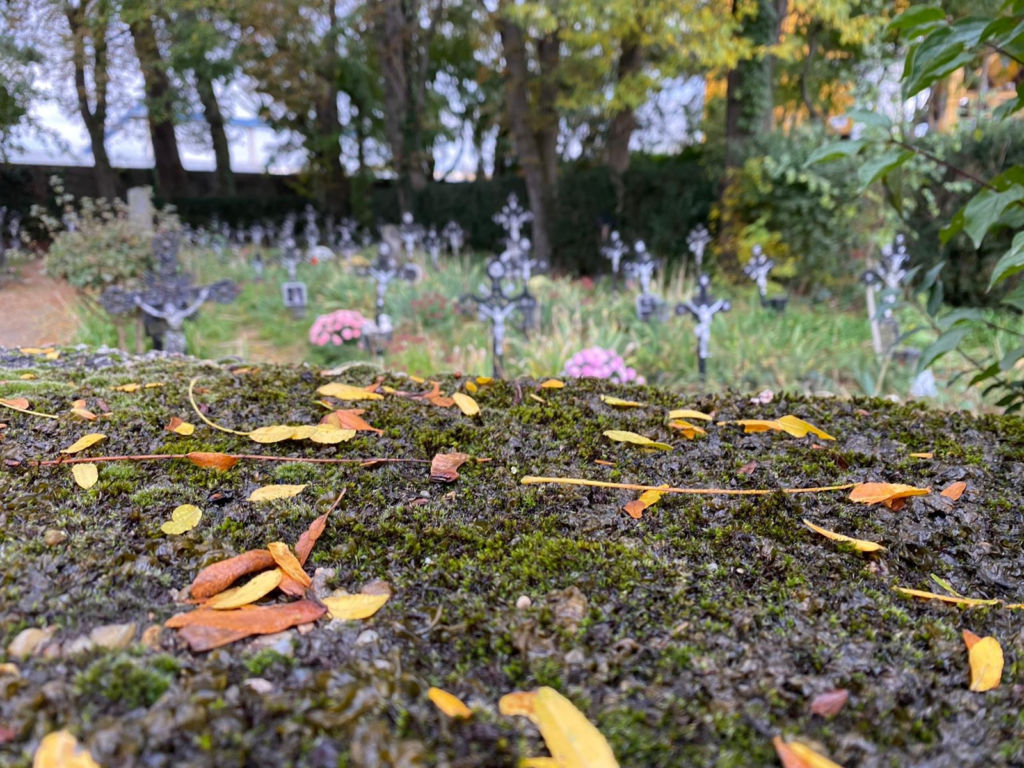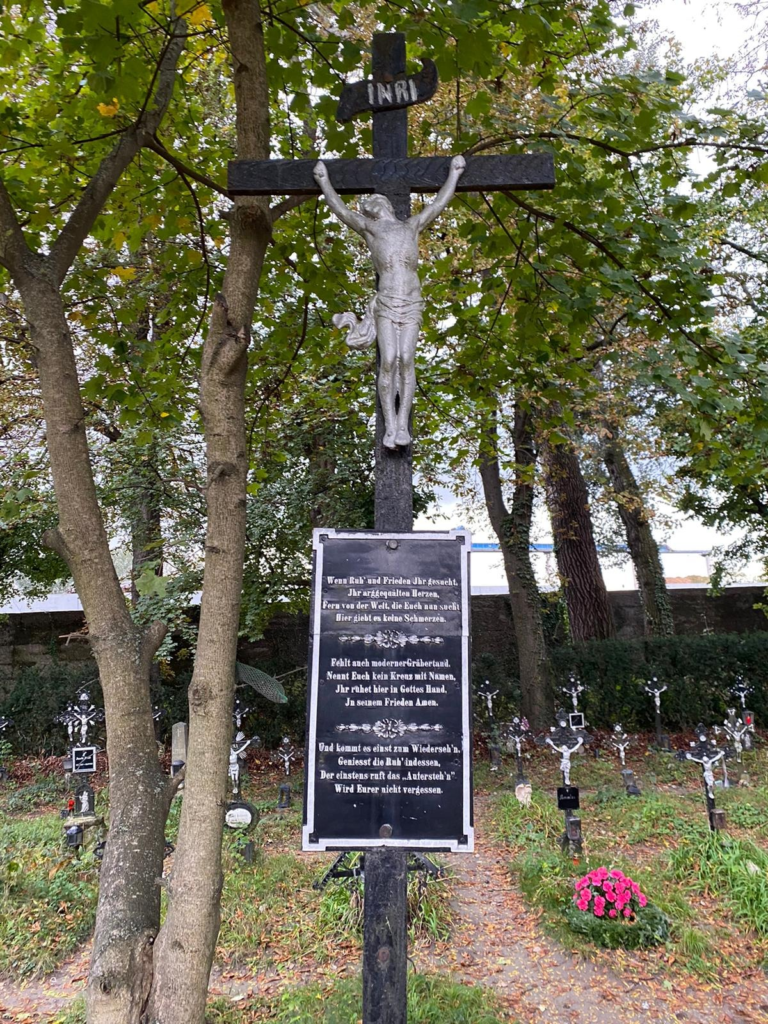The Poetics of a Cemetery for the Nameless
‘Vienna’ is not just a place: it is an idea of a place, as it exists in everyone’s head. Yes, its centre is insanely beautiful, designed to give even the most balanced, level-headed individual a case of Stendhal syndrome. (If you are into representative imperial architecture, that is.) But ever since I’ve moved to Vienna in the autumn of 2019, I have been trying to explore the Vienna that does not really feature in the tourists’ guidebooks. The Vienna that even some Viennese never see. Or choose not to see, in some occasions.

This past weekend, I decided it was time to visit an especially remarkable place – far away from the representative centre, not only by geographical distance. The place I am referring to is the so-called Alberner Hafen (which in German is a bit giggleworthy, as Albern is not only – obviously – the place name here, but also the German word for ‘silly’, so it’s a Silly Harbour, really).
But there was nothing albern, nothing silly at all, about Alberner Hafen. Quite the contrary, in fact.

The reason why I went was not some subconscious harbour fetish, however (is that even a thing??), but, much rather, my desire to explore one of Vienna’s best-hidden – and actually eminently chilling – cemeteries: the Friedhof der Namenlosen, a cemetery of the nameless.

The cemetery, already the second of its kind in this location (the first one no longer exists, however), was in use from 1900 to 1940 (though there appear to be subsequent burials), to provide a final resting place for those who had drowned in the Danube – and its location is owed to the Danube’s currents that had repeateldy resulted in bodies of drowned individuals being washed ashore at this particular place.
Josef Fuchs, an undertaker, chose to take care of this cemetery and to commemorate the (often, but not always, nameless) bodies with proper burials and iron crosses for headstones, detailling what little could be established about those who had died in the cold grave that is the Danube. To the present day, many decades after its being closed for additional burials, the cemetery is maintained and the site of a little chapel.

Upon approach, one is greeted by a legion of crucifixes, emerging from the ground: a view designed to chill any visitor to the bone.

Many graves merely display ‘Namenlos’ (‘nameless’) or some variation thereof, followed by e. g. the date of when the body was discovered. But there are some exceptions, and what struck me in particular about these exceptions (the very reason, in fact, why you are reading about this on our project blog!) was that a little poetic landscape had been created.
Drowning is a terrible death. What is particularly moving about the Friedhof der Namenlosen, however, is that it has to deal with an almost tragic dualism.
The individuals who drowned, and whose bodies were snatched away by the Danube, only to end up in a random location, were remembered by their relatives and friends in another, distant place, potentially without finding out about the final whereabouts of their loved ones. Memory without a place.
At the same time, at Alberner Hafen a loving memory was created of those whose identity remained (mostly) unknown, by those who had no memory of the poor individuals during their lifetime. Memory without knowledge.

This incredibly intense emotional conundrum, going straight to the very centre of all human fear and anxiety, about what could happen, what will happen, to us after we die and there is no-one to remember us, to provide us with a dignified burial, invites artistic reflection, it invites poetry, to give shape to, and to channel, our most profound emotions.
I tried to capture the complexity of emotions in black and white photography, on film – the closest I got, I think, is this image of the funerary plaque for Adolf Kraftel.

His name appears to be fading into the background. Nature, sharp and in the foreground, gives eternal peace to those who died under terrible circumstances.
Photo (c) P. K. (Oct. 2020), taken on Kiev 80 with Fomapan 400 film. No reproduction or use without the author’s explicit consent.
Considering the melancholic, yet deeply serene, poetic setting, I was especially moved to find a handful of actual poems – poems that, to my mind, began to form a poetic miniature landscape – and invite us, as students of the ancient world, to reflect upon such complex forms of collective commemoration, in the face of a most intense emotional human experience, more broadly.
In my telling the poetic story of the Friedhof der Namenlosen, I will follow my own journey of discovery, not the designed layout of the cemetery (I never explore the places I visit in a structured, pre-defined manner: otherwise I’d only see what others have seen before me). (In instances of prose/verse mixes, I have given the poetic part in bold.)
The first piece that caught my attention is this one (which I also caught with my old, analogue Russian medium format camera):

Hier ruhet
Herr
Hans
Mallauch
geb. am 30. Mai 1889, gest. am 18. Sept. 1909
Hier lieg ich in kühler Erde,
Wollt noch nicht und musste sterben,
Musst aus Eurer mitte gehn,
Im Himmel gibt’s jedoch ein Wiedersehn.
Ein Opfer seines Berufes.
Ruhe sanft!
In English:
Here rests Mr Hans Mallauch, b. 30 May 1889, d. 1909.
In the cold soil, here I lie,
Did not yet wish to, but I had to, die,
From your midst I was forced to go,
but in heaven we shall meet again.
A victim of his profession.
Rest peacefully.
The second monument that caught my attention was one of the very rare actual headstones in this cemetery:

Hier ruhet
Rudolf Beier
aus Ben(n)isch Schlesien
welcher 3./3. 1907 im 33.
Lebensjahre verunglückte.
Es ist mit Thränen Dir
geweiht
Schlummere sanft in
Ewigkeit.
Gewidmet
von Deinen Lieben.
In English:
Here rests Rudolf Beier aus Ben(n)isch Schlesien who died in an accident on 3 March 1907, aged 33.
To you: under tears we dedicate this –
Sleep, for all eternity, in bliss.
Dedicated by your loved ones.
Finally, I arrived at the cemetery’s centre, in which there is a much bigger crucifix, also decorated with a poetic inscription:

Wenn Ruh’ und Frieden Ihr gesucht,
Ihr arggequälten Herzen
Fern von der Welt, die Euch nun sucht,
Hier gibt es keine Schmerzen.
––––
Fehlt auch moderner Gräbertand,
Nennt Euch kein Kreuz mit Namen,
Ihr ruhet hier in Gottes Hand,
Ja seinem Frieden. Amen.
––––
Und kommt es einst zum Wiederseh’n
Geniesst die Ruh’ indessen,
Der einstens ruft das “Aufersteh’n”
Wird Eurer nicht vergessen.
In English:
Was it quiet and peace you had hoped to find,
You souls, badly tormented,
Far away from a world that is in search of you:
There is no pain in this place.
––––
Funerary trinkets of a modern age may be lacking,
No cross might reveal your name:
Yet here you rest in the hand of the Lord,
In his peace, in fact: Amen.
––––
And if one day we shall meet again,
Enjoy your rest until then,
He who will call for you to rise,
Will not forget you.
A final poem, the only one with its author – Graf Wickenburg – explicitly mentioned, awaited me upon leaving the cemetery, right by the entrance, though only visible to those looking back, to the chapel:

Tief im Schatten alter Rüstern
Starren Kreuze hier am düstern
Uferrand.
Aber keine Epitaphe,
Sage uns wer unten schlafe,
Kühl im Sand.
Still ist’s in den weiten Auen,
Selbst die Donau ihre blauen
Wogen hemmt.
Denn sie schlafen hier gemeinsam
Die, die Fluten still und einsam
Angeschwemmt.
Alle die sich hier gesellen,
Trieb Verzweiflung in der Wellen
Kalten Schoß.
Drum die Kreuze die da ragen,
Wie das Kreuz das sie getragen,
“Namenlos”.
In English:
Deep under the old elm trees’ shade
Crosses silently rise from a dark river bank,
But no epitaphs
Reveal to us who is sleeping
Cold, in the sand.
The meadows, wide, lie in silence,
Even the Danube’ blue waves
Are stalling.
For here, they all sleep together,
Those whom the floods, quietly, all deserted,
Have washed ashore.
Everyone who has gathered here
Was driven into the cold womb of the waves
By Despair.
Hence the crosses, rising here from the ground,
Similar to the crosses that they had to bear:
“Nameless”.
I have written about ancient Roman epitaphs for those who died at sea in my personal blog, several years ago, and for different reasons. If you are interested (and you probably are, because this is a page about Roman verse inscriptions after all!), you can read my thoughts of yesteryear on The Petrified Muse here.
It is astonishing, as well as deeply moving, to see the similarities and differences, across cultures, across many centuries.
Yet, what became apparent to me at Vienna’s cemetery of – and for – the nameless, more apparent than ever before, with clarity, was the way in which the extremes of our human condition and experience trigger the desire to interpret, to order, to give sense and meaning to the unfathomable, the heartbreaking, the deeply moving through poetry.
And in that, places that provide us with these experiences and emotions in great density, become not only funerary (religious, …) landscapes. They also get turned into poetic ones, in which we can proceed from individual experiences to reflections on our human condition to a poetic reordering of our disturbed, disturbing universe at the point of departure.
The other thought I had was this: is it not remarkable that, even though we may not know someone’s name, even though we may have died under horrendous circumstances, even though all of this may have happened far away in time and space, there are individuals out there who, out of goodness of their own hearts and their deeply held convictions and beliefs, will ensure that even the lowliest and most desperate among us, will find dignity after death? And do so even after more than a century?



Thanks, Peter. A lovely place and a lovely piece. Memory is a tricky business, somwtimes I like to think of it as music from a choir: many voices make it, yet sometimes all we’ve got is not even the melody. Just a background or the fragment of the baritone.